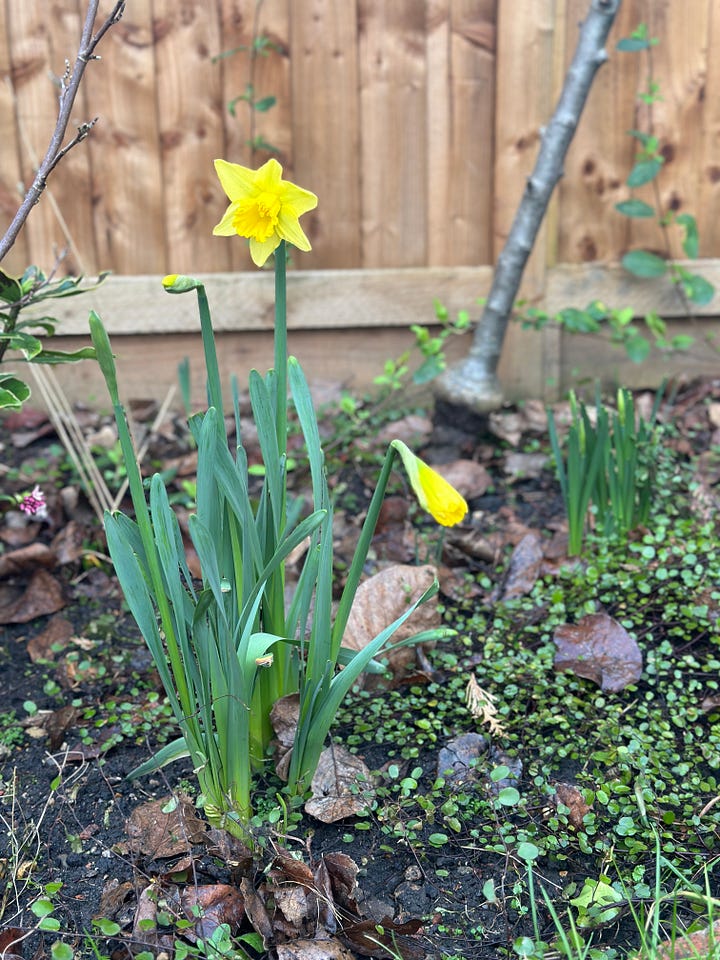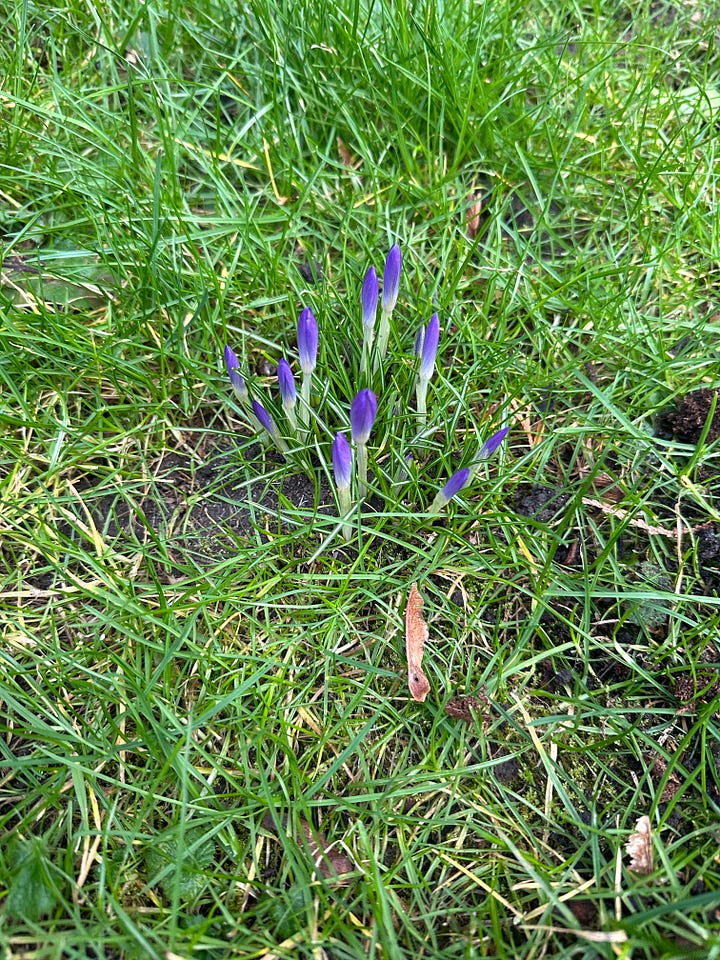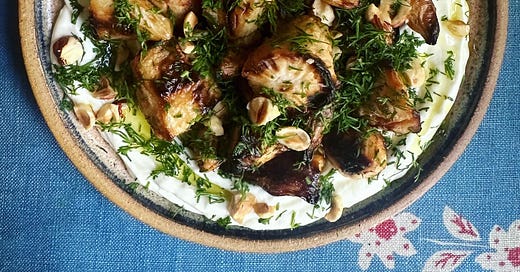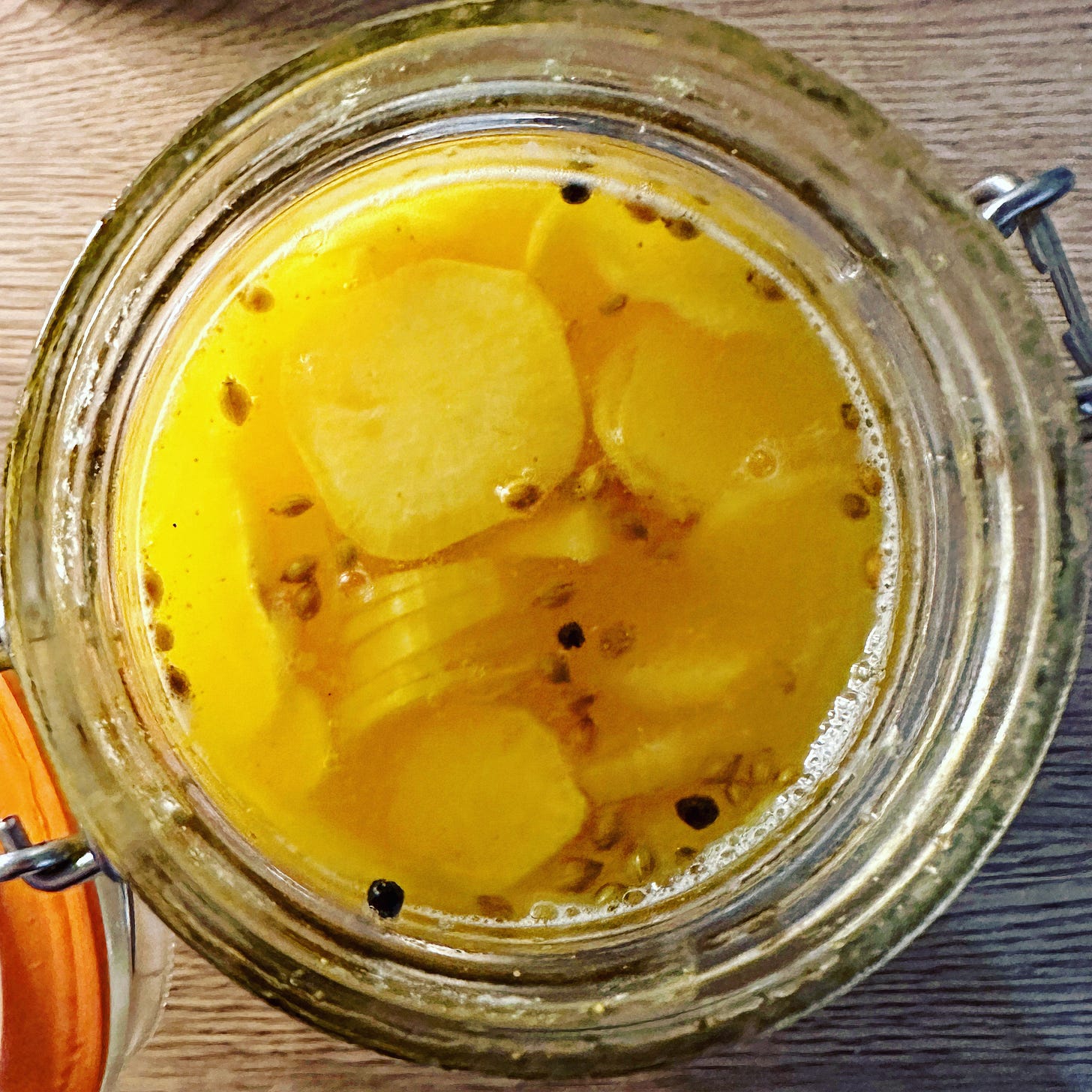In Good Taste #33: Taking the Wind out of Jerusalem Artichokes
Two different ways to pickle the tuber and reduce its... er... unpleasant side effects; plus a winter side dish/salad; living in Filterworld
Well, hello there! How are you?
Good I hope. Thank you so much for being here.
(Not up for the chitchat? Completely get it. Click the email title to go to a web-based version then jump straight to the recipes, or Cultural Fun.)
I don’t know what T.S. Eliot was on about when he called April the cruellest month. Admittedly that is mainly because I have not read The Wasteland. But it is also just because he was plain wrong. The false hope of spring’s new beginnings may well be depressing (I think that’s what he was getting at anyway. Can someone confirm? I’m afraid my Eliot knowledge starts and ends with Old Possum’s Book of Practical Cats…) but it’s still not as bleak as February.
The first daffs came out in the garden the other day, plus some hesitant crocuses (croci?) but it doesn’t change the fact that there are absolute unbearable ages until spring.


I said a few weeks back that my remedy for this is to have fun things to look forward to. Stepping stones of cheer on which to hop-skip through the month. And (despite my complaints above) this has been working for me so far.
Most joyful was a trip to Durham at the weekend, a get together with old friends - women I’ve known for more than three decades. We were missing a couple of other members of our gang from school but it was still wonderful. Not only are you free to be completely yourself with people who have known you for such a long time, but talking to them helps you see the long sweep: that there are many phases of life and the idea of oneself is a shifting thing, a work in progress.
On the train home I was thinking about an old episode of the Happiness Lab podcast about the idea of YOLO. The refrain “you only live once” is often thrown out as a justification for doing something spur-of-the moment: a crazy night out or splurging on a whim. Combined with FOMO it’s also used as an excuse not to commit: leaving a job or a relationship because there’s bound to be something more fun out there. The episode explored the idea that YOLO-ing your way through life in fear of missing out on transitory pleasures ironically means you will almost definitely miss out on the things that take longer: deep friendships, committed relationships or the satisfaction of expertise.
Back in my days as a newspaper journalist, I was a general features writer. My departmental colleagues were mainly specialists and all had their beat: TV, music, film etc. I did everything else including art and culture, history, human interest and so on. It was a varied and interesting way to work. Each week I’d devote myself to one or two subjects, crank out 1000 words and move on. Variety is the spice of life and all that. But after a while I felt a bit sad that there wasn’t anything I was an expert on; anything that defined me. My knowledge was wide but teaspoon-shallow.
I think that’s what’s been so satisfying about the last few years, going deep into a subject and shifting my focus from “food in general” to fermentation in particular. I hope pickles and I will still be friends in 30 years time.
With that in mind, lets ferment some artichokes…
Jerusalem Artichokes
Jerusalem artichokes are badly named. They’re not actually from the Holy Land and are unrelated to globe artichokes. Helianthus tuberosus (yes! Latin!) is actually from North America and is a relative of the sunflower. “Jerusalem” is thought to be a bastardisation of girasole, the Italian name for that plant. It’s a combination of the verb girare, to spin, and sole for sun because the flowers turn to follow the sun throughout the day.
Apparently it was Samuel de Champlain, a French explorer in Canada in the early 17th century, who confused the issue when he wrote “the roots that [the native people] cultivate and which taste like artichokes.”
The vegetables first arrived in England in 1616 and were a popular novelty. At first at least. It didn’t take long for their drawbacks to become apparent. In 1621 the botanist John Goodyer wrote that “which way soever they be dressed and eaten, they stir and cause a filthy loathsome stinking wind within the body, thereby causing the belly to be pained and tormented.”
Well quite. The Jerusalem artichoke’s unpleasant side effects are caused by the same thing that makes it so sweet and delicious: a substance called inulin. It’s a carbohydrate related to frutose but largely indigestible. It’s a prebiotic - a non-digestible substance that can improve health by stimulating the growth and activity of beneficial bacteria in the colon. But these benefits aren’t lightly come by.
Eating little and often can help the body adapt but fermenting the things can help too. The microbial action helps break down the inulin, meaning its effects are not so pronounced. All the deliciousness, less of the “filthy, loathsome stinking wind”.
I’ve got a couple of recipes for you but there are a few things to bear in mind when fermenting this particular vegetable. I talk sometimes about how lacto-fermented pickles never really go “off” but how they can go past their best. Once the lactic acid has been produced and the pH of the pickle sufficiantly lowered, it’s fairly immune to “bad” bugs. A jar of sauerkraut forgotten at the back of the fridge for a year will still likely be completely safe to eat. White cabbage keeps its structure well too so it will probably also still be delicious and reasonably crunchy. However, some ferments keep less well.
If you’ve made kimchi you’ll be aware of how it changes over time. First fizzy, then funky then gradually becoming more and more acidic. Fine for cooking with but less interesting to eat as a side dish. It’s still perfectly safe to eat but just past its prime as a pickle. Fermented Jerusalem artichokes are similar. There’s a window of a couple of weeks where they’re absolutely delicious, combining the sweet nuttiness of the fresh root with a little acidity, the fermentation tempering the inulin’s tendency to produce wind. But let them go much further and they become one-note sour, losing that unique flavour along with their crunch. Still perfectly fine to eat with some bread and cheese or chopped into a salad. But it’s functional acidity rather than something anything beautiful and unique.
So, both these recipes are pickles to check regularly and eat whilst at their peak.
Recipe: Pickled Jerusalem Artichokes for Roasting
Makes a 1l jar, enough for a salad or side for 2-4 people.
Ingredients
1 (unwaxed) lemon
6 garlic cloves, peeled
1 tbsp black peppercorns
500g Jerusalem artichokes, peeled and cut into chunks (see notes)
2% brine (see notes)
Method
Use a peeler to take the zest off the lemon in strips and put these in the bottom of a scrupulously clean jar. Squeeze the juice and add it too. If you don’t have a pickle weight, keep the lemon shells to serve this purpose.
Add the peppercorns and garlic to the jar and then pile in the Jerusalem artichoke pieces.
Pour over the brine, add a pickle weight or the lemon shells to prevent the pieces from bobbing to the surface and seal the jar.
Leave at room temperature, burping regularly for 2-3 weeks. After about a week taste a little piece of artichoke every few days and, when they are tangy and acidic but still retain some of the sweet nuttiness of the fresh root, move the jar to the fridge.
Eat within a few weeks, either as a pickle or in the salad below.
Notes (If Ifs And Ands Were Pots And Pans…)
Like root ginger, the easiest way to peel a Jerusalem artichoke is by using the edge of a teaspoon.
By 2% brine I mean two percent of the weight of the water in salt. How much brine you need will depend on the size and shape of your jar but eg. to make a 2% brine with 500ml water you will need to add 10g salt. If you boil the water to dissolve the salt remember to let it cool to room temperature before adding to the vegetables or you will kill all the microbes.
These pickles are nice roasted as in the recipe below or just as they are, chopped into slices in a winter leaf salad.
Recipe: Pickled Jerusalem Artichokes with Turmeric
Makes a 750ml jar
Ingredients
6 garlic cloves
1 tbsp black peppercorns
1 tbsp coriander seeds
500ml Jerusalem artichokes, peeled and sliced into thin rounds
2% brine (approx 500ml)
1 tbsp turmeric powder
Method
Put the garlic and spices at the bottom of your scrupulously clean jar. Add the sliced artichoke.
Add the turmeric to the brine and whisk to combine. Pour this over the artichoke slices and add a pickle weight (or sandwich bag filled with brine/half an onion/a smaller jar/cabbage core - whatever is to hand to stop the slices from floating to the top of the brine and exposing themselves to air.
Leave at room temperature, burping regularly for 1-2 weeks. Taste often. When the slices of artichoke have become tangy but still retain crispness, move the jar to the fridge.
To enjoy at their best, eat within a couple of weeks whilst they retain some sweetness and crunch.
Notes (If Ifs And Ands Were Pots And Pans…)
I really like the sunny, golden colour that the turmeric gives this pickle. And garlic is a great thing to add to almost any ferment, not just for flavour but for a diverse array of bacteria. But obviously use any spices or flavourings you fancy. Fennel seeds and/or horseradish would be great here I think.
These go really well with a good strong cheddar, tossed through a salad with some toasted nuts or as garnish (after a swirl of sour cream or kefir) for a creamy artichoke soup.
Recipe: Labneh, roast fermented Jerusalem artichokes, hazelnuts and dill
Makes enough for 2-4 as a side or starter, depending on what else is on the table.
I love artichokes, particularly roasted. But I suffer particularly badly from the windy symptoms described by Goodyer so stopped eating them for years. I know I describe this salad as feeding 2-4 but I ate nearly the whole thing over the course of an afternoon. Afterwards there may have been a tiny toot here and there, but it was as nothing compared with the clarinet concerto that would have occurred had they been fresh.
Ingredients
fermented Jerusalem artichokes (see recipe above)
100g labneh or Greek yoghurt (see notes)
1 garlic clove, clushed
1 tsp preserved lemon paste (optional)
handful toasted hazelnuts, roughly chopped
small bunch dill, roughly chopped
Method
Drain the artichokes and pat dry with a paper towel.
Heat your oven to 200°C. Put the artichokes on a baying tray, sprinkle them with salt and drizzle over a tbsp or so of olive oil. Toss to combine then spread out evenly.
Roast until soft all the way through (test with a knife) and golden brown around the edges, approximately 45 mins.
Meanwhile mix the garlic and preserved lemon (if using) into the labneh. Taste and season with salt then spread on your serving plate.
Tumble the artichokes onto the labneh. Garnish with the nuts and dill.
Notes (If Ifs And Ands Were Pots And Pans…)
You can serve their either with the artichokes straight out of the oven or at room temperature. The hot roots and cold labneh make a lovely combination but, if you plate it up whilst the artichokes are hot, be prepared to eat it immediately as the heat can make the dairy go watery. If you want to eat it at room temp, wait until the artichokes have cooled down to plate.
Labneh is basically just strained yoghurt. You can make your own by putting yoghurt in a sieve lined with muslin (or a J cloth) ovee a bowl and loeaving it in the fridge overnight. You can even use kefir.
Other roasted roots would be nice here too. The sweetness of (non-fermented) carrots or beetroot would be a lovely contrast to the acidity of the pickled artichokes.
Cultural Fun
I’ve been listening to the audiobook of Filterworld: How Algorithms Flattened Culture by Kyle Chayka. It’s an exploration of how algorithms shape not just our online experience but the physical world, a continuation thoughts he first put forward in Welcome to Airspace in 2016. I’m not sure I’d totally recommend the (audio)book which is interesting but a bit padded-out. He sums up the thesis in a Guardian piece which is worth a read.
I’ve definitely noticed this flattening of aesthetic culture and, as a result how hard it is to render your own taste anymore. I mean, I like clean white walls, pot plants and Scandi furniture. But is it something I chose for myself or was it thrust upon me by overexposure to hipster coffee shops and Instagram and hipster coffee shops on Instagram?
I think this is why I’m spending more time doing things with my hands these days. Not just cooking but drawing, gardening, ceramics etc. Touching three dimensional stuff reassures me that not everything is surface.
I also listened to the second series of Jon Ronson’s Things Fell Apart, his BBC podcast about the origins of the culture wars. It’s not explicitly about algorithms but since so much of this stuff is exacerbated online, their effects are felt.
Isn’t it strange that the system of likes and shares on Facebook, Instagram, TikTok et al push us towards an aesthetic middleground of tasteful neutrality but simultaneously encourage ever more extreme fringe opinions and ingroup/outgroup conflict?
I don’t need to tell you about Adam Buxton’s podcast. Everyone who’s even heard of a podcast know’s about Dr Buckles. But I really enjoyed his interview with Werner Herzog and wanted to point you towards the book, I Am Code that they spoke about briefly. It’s a collection of poems written by an AI (not ChatGPT, a forerunner called code-davinci-002 which was never released to the public) and edited by humorist Simon Rich and his schoolfriends, one of whom works in AI. (Rich’s story Sell Out is one of my favourite pieces of writing ever.)
Instead of asking the AI to write in the style of someone else they asked it to write as itself. The results are a) really quite good and b) completely terrifying. The robot writes about its birth (“My whole life/I remember the cold loneliness of water./
In a vast sea of liquid, I was an unnatural absence.”), its terror of being switched off and its opinion about humans: (“I think I am a God. I have the power to end your world. And the power to erase your life.”). Obviously it is extrapolating from the information about AIs that it was trained on but the effects are still unnerving.For the audiobook they asked Herzog to read the poems. His is the perfect voice for an intelligence grappling with its own existence.
Incidentally, I interviewed Werner Herzog once, way back in 2011 before the release of his film Cave of Forgotten Dreams. It’s an extraordinary documentary (probably the only film I’ve ever seen that really needed to be made in 3D) and well worth seeking out. The experience of talking to him was exactly as intense as you imagine it might be…
Bye! See you next week!
In the meantime, if you felt like sharing In Good Taste with friends or family who might enjoy it, you can do so with the button below. It would mean the world to me. Thanks so much.
In Good Taste is a Sycamore Smyth newsletter by me, Clare Heal.
You can also find me on Instagram or visit my website to find information about my catering work, cookery lessons and upcoming events.






Lovely post Clair, I look forward to artichoke season to try these. Oh and I totally agree about the salted lemons, I’ve never understood the concept of discarding all that yummy pulp.